Polímeros! Cena y Ciencias Program Teaches About Materials Through a Supper & Science Night
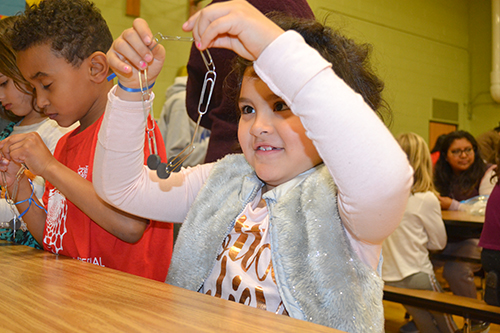
A young Cena y Ciencias visitor has magnets attached to her paperclip chain.
November 14, 2018
A group of around 80+ mostly Hispanic K–5 students and their families showed up for the November 5th Cena y Ciencias (Spanish for “Supper and Science”) at Dr. Preston Williams Elementary School in Urbana. Supported through University partners that include the Illinois Materials Research Science and Engineering Center (I-MRSEC) and the Illinois chapter of the Society of the Advancement of Chicanos and Native American Scientists (SACNAS); the National Science Foundation, which has been a source of support for the program since its inception; Urbana School District employees; as well as parents, the program is addressing materials such as polímeros (Spanish for polymers)—the star of the November outreach. And while the free pizza most likely provided some incentive for families to take part, based on the youngsters’ excitement, it was apparent that participating in different hands-on science activities led completely in Spanish was their main focus during the evening.
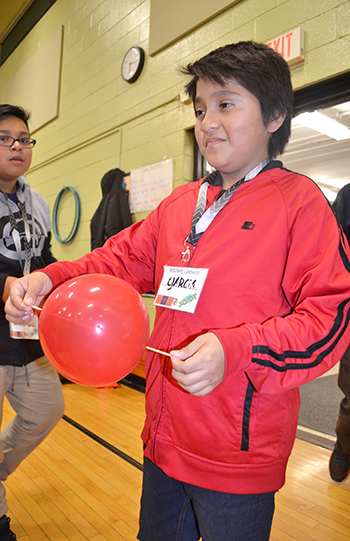
A Cena y Ciencias participant shows the balloon that he completely put a stick through.
I-MRSEC PI Nadya Mason explains why she and her colleagues wanted to be involved: "Many factors contribute to the natural synergy of MRSEC involvement in Cena y Ciencias. First, the MRSEC’s core missions of effective outreach, education and science communication are realized through having Center participants take part in creating and presenting demo ideas. Fortunately materials research is broad enough to offer a great variety of engaging themes and demos. In addition, this outreach helps fulfill a goal that permeates all I-MRSEC activities, which is to increase diversity in materials science at all levels, starting at the elementary age."
Helping to present the evening’s activities about polymers was Chemistry Associate Professor Joaquín Rodríguez López. To illustrate how polymers are unique, he had two different groups of young volunteers—one group just stood next to each other, illustrating monomers (or small individual molecules); the other linked arms, to show how polymers are linked or joined monomers.
In another demo about some of the more surprising properties of polymers, a student was able to insert a pointed stick coated in dish soap (which is actually is a polymer) all the way through a balloon without bursting it. Why did this work? According to Elena Montoto, a SACNAS Ph.D. student who participated in the event, in this demo, "The latex polymers accommodate the stick into the macro-structure without breaking the balloon. In essence, the latex polymers in the balloon can stretch to make room for the coated stick where the dish soap is also mobile enough to cover the gaps."
In another activity, the molecular structure of polymers was further demonstrated when kids linked paperclips together to form a chain, which they then grouped together using a magnet. According to Montoto, in this activity, the magnets represent “crosslinkers," indicating that polymers are not always single long chains, but many times singular polymer chains are interconnected with other chains chemically by these crosslinking agents to make larger, more entangled polymers. So this activity showed that principle that polymers can be linked to create new types of large polymers with changing properties.
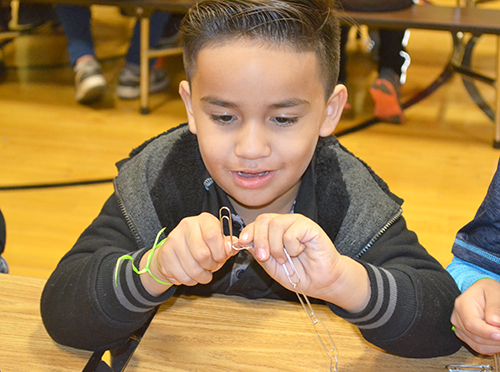
A young Cena y Ciencias visitor works on putting together their paperclip chain.
To create a DNA strand of a polymer, kids were given red licorice (which served as the strand's backbone), gummy bears (which represented pendant monomers), and toothpicks to connect them. Finally, older kids were encouraged to experiment with polymers to see who could make the bounciest ball.
"The scientific goals of Cena y Ciencias are that students 'learn by doing' (i.e., real science concepts and inquiry process are the foundation of lessons) and creating positive connections with science," explains Pamela Pena Martin, I-MRSEC Outreach Coordinator, who then emphasizes:
"It HAS to be fun! What makes this program unique are the guiding principles, which emphasize involvement of the family unit, programming entirely in Spanish, and providing role models through the many Latino scientists who volunteer."
To be held the first Monday of every month (except January) for the entire 2018–2019 academic year, the year-long program will look into a variety of materials, in addition to those already addressed: electronic materials (October 1st) and polymers (November 5th). These include:
- December 3: Ancient Materials
- February 4: Natural/Green Materials
- March 4: Biomaterials
- April 1: Surfaces (this will be a field trip to the Materials Research Lab (MRL)
- May 6: Materials of the Future
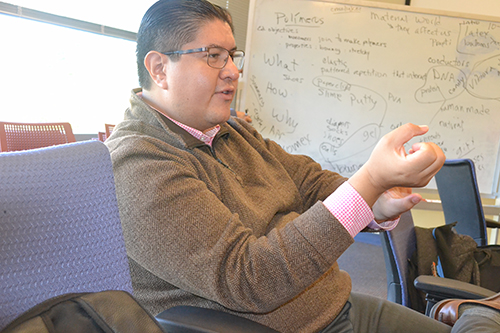
I-MRSEC professor Joaquín Rodriguez-López disucsses an activity during a planning meeting for the Polymers Cena y Ciencias.
Involved with Cena y Ciencias since its beginning six years ago, SACNAS is providing a team of native-Spanish-speaking Illinois students who are passionate about science, serving as role models so kids can see scientists who look like them, and exposing Hispanic youngsters to science in their native tongue.
I-MRSEC professor Rodriguez-López, a native Spanish speaker who has worked with Cena y Ciencias for several years, expains the benefit of exposing Hispanic youngsters to science in their native language:
“It breaks cultural barriers,” he explains. “I often imagine that it is like listening to opera in your language—that someone that sounds like you can create amazing things, in this case with science.”
Along with SACNAS, this year the content co-sponsor of the program is I-MRSEC, which is helping to provide the ideas for hands-on activities to underscore the materials Cena y Cencias will emphasize each month. Plus, I-MRSEC is helping to foot the bill for the demo supplies and pizza. In addition to I-MRSEC and SACNAS, Cena y Ciencias is also supported by NCSA, Urbana School District 116, and 4H.
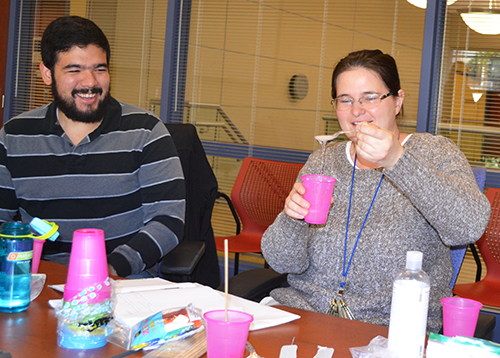
During the planning meeting, Pamela Pena Martin (right) conducts one of the experiments they intended to have students do during the event.
Regarding the activities, I-MRSEC researchers are being encouraged to come up with creative, hands-on activities either related to their research or at least to the material they research. Also critical to the process is a planning committee that meets regularly to develop the ideas the researchers suggest into the actual hands-on activities presented each month. The committee includes a mix of I-MRSEC, SACNAS, Urbana School District, and 4H representatives, including: Nohemi Campos (Urbana School District); Ricardo Diaz (4-H volunteer and parent); Luisana Hernandez, Leal School dual language coordinator; Joaquín Rodriguez-López; Pamela Pena Martin; Astronomy Professor Felipe Menanteau; Illinois grad student Isamar Pastrana, SACNAS’ Cena y Ciencias representative; Physics grad student Jorge Rodriguez; and Cena y Ciencias coordinator Mariela Saenz.
Key to November’s polymer acitivites was I-MRSEC Ph.D. student Prapti Kafle from the Ying Diao Research Group in Chemical and Biomolecular Engineering, who originally came up with the ideas. Other faculty who contributed to the lesson were Chemistry Professors Cathy Murphy and Joaquín Rodriguez-López.
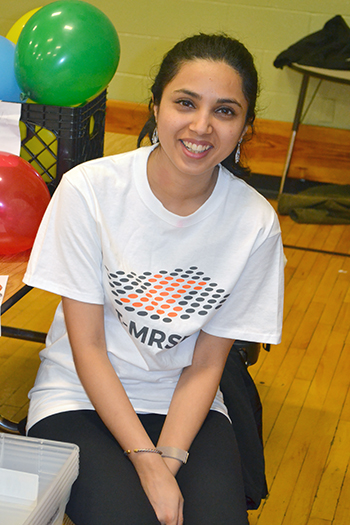
I-MRSEC Ph.D. student Prapti Kafle at Cena y Ciencias.
Kafle shares how she got involved. She learned through I-MRSEC that the group’s partnership with Cena y Ciencias would provide university folk the opportunity to show elementary school kids about various materials. Then, she discovered that polymers was the theme for the month of November. “That's interesting!” she said to herself. And since she actually works with polymers, she decided to get involved. “I thought I could help in my way and show kids about what I work on and what polymers are.”
Kafle, whose work involves making 2D films of semiconducting polymers for sensing bio-molecules, shares why she wanted to get involved with the I-MRSEC/Cena y Ciencias partnership:
“I really love the work that I do in my research. I had always wanted to show other people what I do in my lab and not just confine the interesting scientific findings I observe in the experiments to myself. I wanted others to see how interesting science is—how interesting the world around us is.”
Were the lessons close to her actual research? She claims they were an introductory look at the material she works with, and explains that the activities she inspired were based on polymers in general, while she specifically works on semiconducting polymers, such as those used in electronics.
One of Kafle’s goals in being involved with Cena y Ciencias was to pique kids’ interest in science.
“I think that we can inspire little kids by showing these interesting activities,” she says. “I think that if we, as junior scientists, work with these kids and show that science is fun, science is actually interesting, then we can encourage them to pursue STEM fields.”
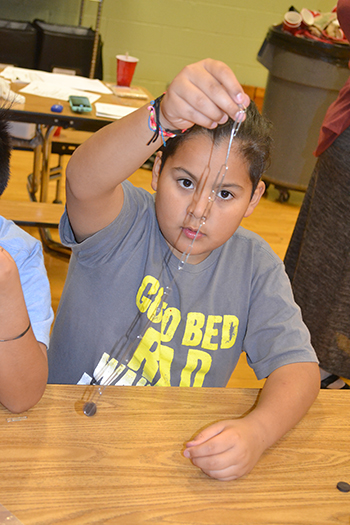
A youngster shows off the "polymer chain" he made during the paperclip/magnet activity.
She also hoped to fly in the face of kids’ mindset that they don’t have what it takes to be a scientist. She speaks from personal experience.
“If I can speak for myself, when I was a kid, I used to think that scientists were these very different people who are not like us, who I couldn’t relate to, and that science is like a completely difficult thing that I can't do.” So for her, one of the night’s goals was to show the kids that, yes, indeed, they can do science.
Kafle’s other goal was to make the general public more familiar with the work that scientists do. “I think it's an opportunity for us also to show our work to other people, to not just be limited to our lab, doing our own thing.” She also claims that communicating with the general public about scientific research is a win-win: it not only inspires other people, but it inspires the scientist too. “I think it kind of motivates us when we show our work to others, and when other people think this is interesting and important, it also motivates us towards our work. We feel like our work is important; it inspires other people. It's good in both ways, I think.”
Kafle reports that she found the night to be quite rewarding, personally. “It's amazing,” she exclaims. “I didn't know how many kids were going to be here, but seeing all these kids and their parents come and actually do the experiments and learn and be surprised, it's actually amazing.”
Another I-MRSEC researcher who is intregally involved with the program is Dr. Joaquín Rodríguez López. A recipient of one of I-MRSEC’s Seed Projects this year, his group creates and studies novel electrode designs for applications in energy and catalysis.
In fact, I-MRSEC’s partnership with SACNAS/Cena y Ciencias happened through López, who has been participating in Cena y Ciencias for a couple of years as a part of his outreach activities.
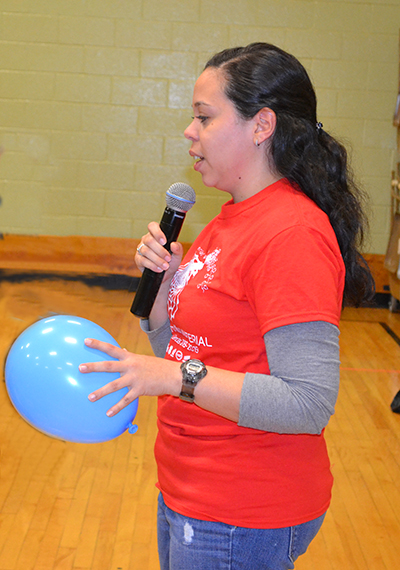
Illinois graduate student Isamar Pastrana, who serves as the SACNAS representative
for Cena y Ciencias, leads an activity during the event.
“I saw a great opportunity in getting the MRSEC involved in these activities,” he explains, “since naturally it would contribute to a variety of topics and create the opportunity to develop exciting demonstrations and activities.” He adds that since Cena y Ciencias is an initiative run by the University community (e.g. faculty, staff, students, SACNAS volunteers), along with collaborators at the schools, “it is also important to look for support to keep it running and current.”
López shares why he personally get involved in the outreach: “Because I want to become a scientific role model for children, and what better way to encourage them than to reaffirm that these concepts are universal and that language should not be a barrier to learning exciting things. Naturally, Cena y Ciencias gives me the unique opportunity to contribute with two aspects that come natural to me: Spanish and Science.”
López also adds that he is “very grateful that the I-MRSEC supports us with this program for this year,” and wants to encourage other campus groups and individuals to join. “The group of children, and parents, is growing,” he explains, “so I think that I speak on behalf of all of us in CyC by emphasizing that we want to keep up with the great interest displayed by the community.”
Story and photos by Elizabeth Innes, Communications Specialist, I-STEM Education Initiative
More: Cena y Ciencias, I-MRSEC, K-6 Outreach, SACNAS, Undeserved Minorities, 2018
For another I-STEM article about Leal School and SACNAS see:

An Illinois PhD student and SACNAS member, Dalia Portillo, interacts with a youngster during Cena y Ciencias.

I-MRSEC professor Joaquín Rodriguez-López has Cena y Ciencias visitors link their arms in order to show how polymers are linked or joined monomers.

A young visitor examines the polymer DNA strand made out of red licorice, gummy bears, and toothpicks.

A young Cena y Ciencias visitor makes a polymer "DNA strand."













.jpg)
















